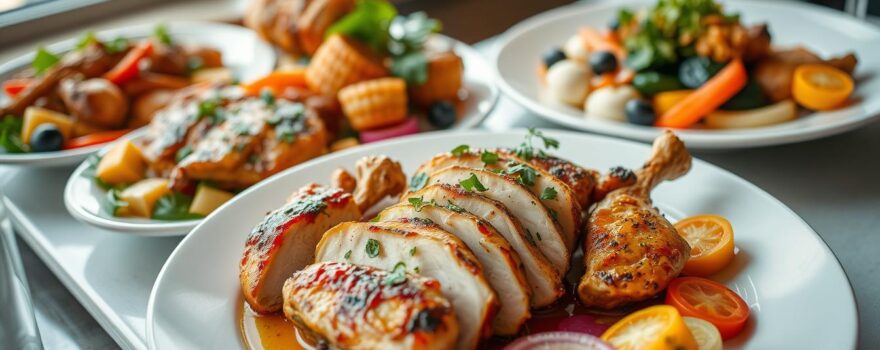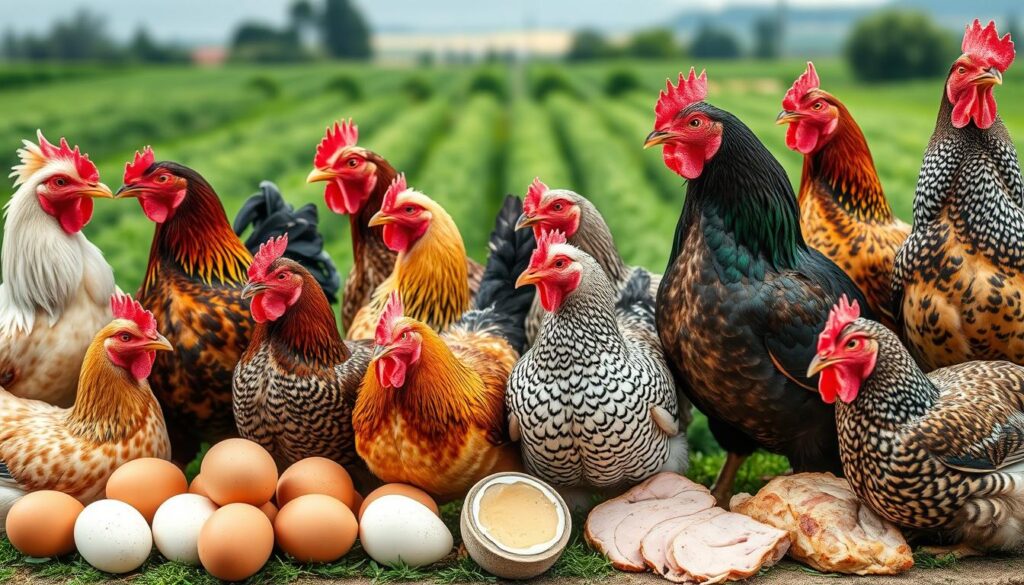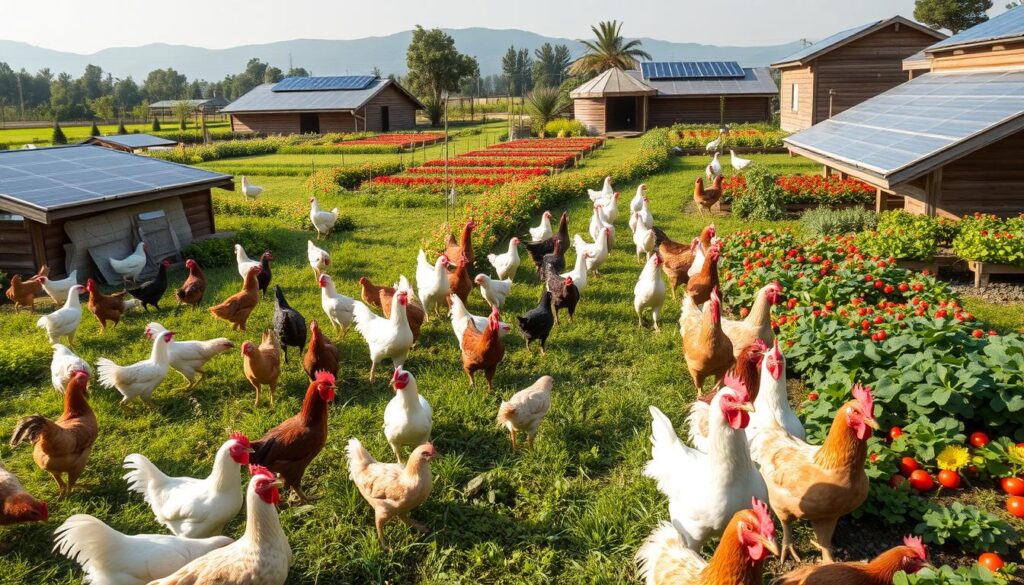
In the fast-changing world of poultry, smart producers see big chances in value-added broiler chicken. They aim for the growing need for top-notch, unique, and specialty chicken. This way, they can reach profitable niche markets and stand out from common broiler chicken.
The FOOD MARKETING POLICY CENTER research series explores how to make value-added broiler chicken products. It covers everything from knowing market trends and what customers want to new ways of processing and branding. This guide will give you the tools to succeed in the world of value-added poultry.
Key Takeaways
- Recognizing the growing demand for premium, artisanal, and specialty chicken products
- Strategies for differentiating value-added broiler chicken products in niche markets
- Implementing innovative processing techniques to add value to poultry products
- Developing effective branding and marketing approaches for value-added chicken
- Leveraging sustainable poultry farming practices to meet evolving consumer preferences
Introduction to Value-Added Broiler Chicken Products
Definition and Significance of Value-Added Poultry Products
Value-added poultry products are processed to increase their value. The rise in poultry consumption shows the importance of marketing. Poultry processors must create new, convenient products to meet demand for premium and specialized chicken products.
Consumer Demand for Premium Chicken Products
The consumer demand for premium chicken products is growing. People want healthier, more convenient, and high-quality poultry products. They look for value-added poultry with better flavors, textures, and nutrition.
This change in consumer behavior opens doors for poultry producers. They can create innovative specialized chicken products that meet new market trends in the poultry industry.
| Country | Commercial Chicken Population (in million birds) | Egg Production (in million) | Meat Production (in tons) |
|---|---|---|---|
| Pakistan | 1,022 | 17,083 | 1,270,000 |
The commercial chicken industry in Pakistan is growing fast. It has seen an 8-10% annual increase for two decades. Investment in poultry has also grown, from 200 billion PKR in 2015 to 700 billion PKR in 2018.
Chicken meat makes up 32.7% of Pakistan’s total meat production. Its consumption is rising because it’s affordable and low in fat.
“The average chicken product consumption per capita in Pakistan is 5 kilograms of meat and 51 eggs annually, demonstrating the significant role of poultry in the country’s diet.”
Identifying Profitable Niche Markets
In the fast-paced poultry industry, success comes from knowing what consumers want. It’s all about finding and serving niche markets. By studying what people want and the latest trends in chicken, producers can make plans to win over customers.
Market Analysis and Target Audience
Today’s market is all about what buyers want. They look for specific things like how the chicken is packaged and sold. Poultry companies that listen to their customers can adjust their products to meet these needs. Knowing who wants premium chicken and what they prefer is key to success.
Emerging Trends in Specialty Chicken Products
The demand for special chicken products is on the rise. People want organic, free-range, and antibiotic-free chicken. They also like chicken that’s raised on pasture for its health and environmental benefits. By keeping up with these trends, producers can offer products that appeal to these health-conscious buyers.
| Niche Market Opportunity | Key Considerations |
|---|---|
| Organic and Free-Range Chicken |
|
| Pasture-Raised Chicken |
|
| Antibiotic-Free and Hormone-Free Chicken |
|
By analyzing the market and understanding what customers want, poultry producers can find profitable niches. This approach helps them stand out and keep a loyal customer base in the changing poultry industry.
Breeding and Raising Broilers for Niche Markets
To make value-added broiler chicken products, you need to focus on breeding and raising. The U.S. broiler industry uses a mix of Cornish males and White Plymouth Rock females. This mix helps the chicken grow fast and have a big breast in a short time. But for premium chicken, you need special breeding and care.
Experts say genetic diversity is key for better broiler chickens. Crossbreeding heritage breeds with commercial lines can improve flavor, texture, and quality. This meets the needs of picky consumers and helps the poultry industry stay diverse.
There’s a growing interest in heritage breed chickens for specialty products. These chickens take longer to grow, but they taste better and are firmer. Small farmers can stand out by offering these unique chickens.

The way you raise and feed chickens also matters for premium products. Pastured poultry, organic feed, and careful care are important for niche markets. By focusing on animal welfare and quality nutrition, you can meet the high standards of discerning consumers.
“Crossbreeding has led to the creation of value-added broiler chickens for niche markets, enhancing genetic diversity and promoting desirable traits for specific market segments.”
The poultry market is changing, and clear meat chicken classifications are becoming more important. Terms like “broiler,” “fryer,” and “roaster” can be confusing. Clearer terms could help highlight the unique qualities of value-added broiler chicken products.
Processing and Product Development
Making high-quality, value-added broiler chicken for special markets needs careful steps. Food safety and quality control are key, as people want the best for their premium chicken. Also, new packaging and labeling ideas help set specialty chicken apart and attract careful buyers.
Food Safety and Quality Control Measures
Keeping food safety is crucial in the chicken world. Strong biosecurity practices like keeping birds safe from dangers are vital. Also, using air chilling meets new tastes for premium poultry products.
Packaging and Labeling Strategies
Creating new packaging and labeling is key for marketing in the niche chicken field. Good packaging makes specialty poultry products seem more valuable. Labels that share the special features and benefits reach out to careful buyers.
By focusing on food safety, quality, and smart packaging and labeling, makers can offer value-added broiler chicken. These products meet the needs of special markets and help the specialty chicken industry grow.
How to Create Value-Added Broiler Chicken Products for Niche Markets
In the poultry industry, adding value is key to attract new customers or keep current ones. This can be done through product differentiation, branding, and targeted marketing. Animal welfare, organic certification, and new processing methods can make broiler chicken products stand out. They appeal to consumers who want specialty products.
Product Differentiation and Branding
To be noticed in the crowded broiler chicken market, producers need to differentiate their products. This means showing off unique production methods like free-range, organic, or antibiotic-free. Building a strong brand and clearly showing its value can lead to higher prices and loyal customers.
Marketing and Distribution Channels
It’s important to reach the right audience in niche poultry markets. Using a mix of old and new marketing ways, like farmers’ markets, online sales, and partnerships with specialty stores, can help. This way, producers can connect with health-conscious consumers who want premium chicken.
“Investing in processing facilities for value-added products like pre-marinated meats and ready-to-cook meals can enhance profitability for producers.”
| Marketing Channel | Advantages | Challenges |
|---|---|---|
| Farmers’ Markets | – Direct connection with consumers – Higher profit margins |
– Limited reach – Seasonal availability |
| Online Sales | – Wider customer base – Ability to showcase product details |
– Logistics and shipping costs |
| Specialty Retailers | – Access to targeted customer segments – Potential for bulk orders |
– Competition for shelf space – Strict quality and certification requirements |
By using these strategies, producers can make broiler chicken products that appeal to niche consumers. This opens up new opportunities for growth in the changing poultry market.
Sustainable Poultry Farming Practices
The demand for high-quality poultry is on the rise. This has made sustainable farming practices more crucial. Producers are now focusing on better animal care and reducing environmental harm. This change meets the growing need for sustainable poultry farming, animal welfare in poultry production, and responsible poultry practices.
Animal Welfare and Environmental Considerations
Big poultry companies have set strict rules for bird health. They feed chickens natural diets, give them enough space, and use humane processing. Some producers aim for niche markets that want poultry produced sustainably and with animal care in mind.
It’s also key to think about the environment in poultry farming. Practices like efficient waste management, saving energy, and water help lessen harm. These steps help producers make chicken products that appeal to those who care about the planet.
| Sustainable Poultry Farming Practices | Benefits |
|---|---|
| Grain-based Diets | Improved animal welfare and reduced environmental impact |
| Adequate Space per Bird | Enhanced animal well-being and reduced stress |
| Humane Processing Methods | Minimized animal suffering and improved product quality |
| Efficient Waste Management | Reduced environmental footprint and resource conservation |
| Energy and Water Conservation | Decreased energy consumption and water usage |
By adopting sustainable poultry farming practices, producers can meet the demand for environmentally responsible and animal-friendly chicken. This approach helps create value-added products.

Regulations and Certifications
Keeping food safe is key when making special chicken products. Biosecurity measures like isolating birds and keeping facilities clean are used. Regulations and certifications also guide how these products are made and labeled.
The USDA Food Safety Inspection Service (FSIS) watches over regulations for value-added poultry. They make sure products follow food safety standards for premium poultry. Producers must follow FSIS rules for labeling requirements for niche chicken products.
Industry-led certifications for specialty chicken products also matter. For example, the Certified Humane Raised and Handled (HFAC) program has certified over 100 million animals. These certifications show a commitment to animal welfare and the environment, appealing to consumers in niche markets.
| Certification Program | Key Facts |
|---|---|
| Certified Humane Raised and Handled (HFAC) |
|
By following regulations for value-added poultry and getting certifications for specialty chicken products, producers show their dedication. They meet the demand for high-quality chicken in niche markets.
Financing and Business Planning
Starting a successful value-added broiler chicken business needs a solid business plan and financial forecasts. The financing value-added poultry business requires a deep look at costs for business planning for specialty chicken, cost analysis for premium chicken products, and profitability projections for niche poultry.
Big poultry companies use vertical integration to cut costs and grow. This means they own many parts of the production and processing. A detailed business plan, with a good cost analysis and profitability projections, is key to getting funding and starting a sustainable chicken business.
Cost Analysis and Profitability Projections
A thorough cost analysis for premium chicken products should look at several things:
- Breeding and raising costs for specialty broilers
- Processing and value-added product development expenses
- Packaging, labeling, and marketing expenditures
- Transportation and distribution logistics
- Regulatory compliance and certification fees
By studying these costs, you can make precise profitability projections for niche poultry. This will help get funding and make sure your value-added broiler chicken business stays strong. Detailed financial plans, like breakeven analysis and return on investment, show investors and lenders your business’s potential.
“Effective cost management is crucial for sustained profitability in chicken farming. Automated systems, data analytics, and technological advancements contribute to resource optimization and cost reduction in poultry farming.”
Conclusion
Creating value-added broiler chicken products for niche markets needs a detailed plan. This includes finding profitable segments, breeding chickens for specific needs, and using strong processing and product development. It also means using sustainable farming, following regulations, and having a solid business plan.
By focusing on what consumers want, producers can stand out. They can use unique branding and explore new ways to market and sell their products. Sustainable farming adds value by caring for animals and the environment.
The future for premium chicken looks bright. As more people want specialty and organic chicken, producers who adapt and offer high-quality products will do well. By taking a comprehensive approach, businesses can thrive in this growing market.